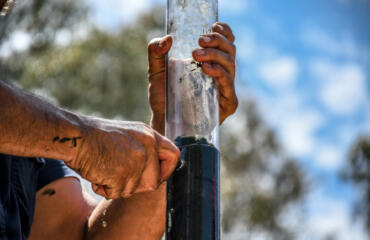‘We talked to a lot of patients to find out what they really want to see. Most of them reply, “I would like to see my relatives’ faces and be able to read”. I was part of Bionic Vision Australia, which aimed to build a bionic eye for the blind.
My Bachelor’s degree was in electronic engineering in Vietnam and I went to South Korea to get my Master’s degree in electronics. For my PhD I worked on the implant chip, especially the stimulator, for the bionic eye. When I started in Melbourne in 2008 there were four main groups who were working on the same goal. Two were from the USA, one in Germany and another group in Japan.

A bionic eye system consists of a camera to capture images in front of the blind, which are then processed by an external unit. That unit then sends the image information to an implant chip. The implant chip sits on the retina surface and it will translate the image information into a current and stimulate the retina. The stimulated signals will be transferred to the brain via a visual pathway and the image is recovered in the brain.
Clinical trials have been done in Europe and in the US. With small numbers of pixels the patients are able to see something, but it takes time to train them. It’s not very efficient. That’s why we need a higher number of pixels. It would be a very significant achievement – for us and for the patients – if they were able to read text, navigate unaided and recognise faces.
It’s very challenging and I was very happy when I got the scholarship to undertake the research. We targeted a chip size of five x five millimetres, but now we target three x three millimetres. That is the surgeon’s preferred size. When you are working with electronics it is difficult, but it isn’t as difficult as putting this electronic device inside human beings.
In Australia there are not many people designing chips: the software licence and the fee for fabrication cost tens of thousands — to hundreds of thousands — of dollars for a single chip. Usually in other countries like Taiwan, the US or South Korea, they’ve got the support and licence and manufacturing fees are very low.
The difficulty here is government funding because the final product would be very expensive and not all the patients can afford to get implanted. Volunteers are very willing to take part in trials.
During my time in Melbourne I made two chips which performed as well as I expected – that was really good because you just never know. You design, you simulate and it works in theory. But when you have the real device it may not work.
I would like to stay in Melbourne. I am focusing on this project. The funding is ending and we have to finish some goals before it does.’
Nahn Tran’s research is titled: “A highly flexible stimulator for a high acuity retinal prosthesis implemented in 65 nm CMOS process”.
* “My PhD” is an irregular series in which The Citizen speaks with recent Melbourne University PhD graduates.


